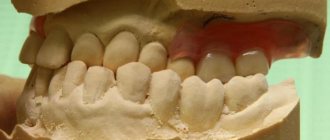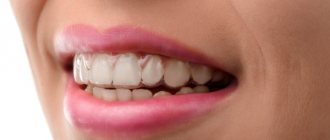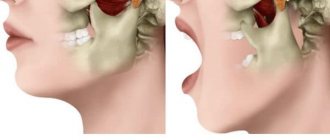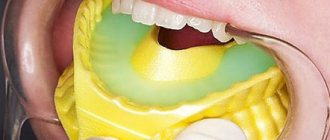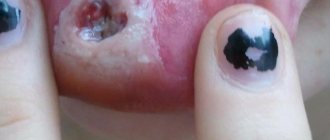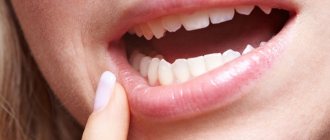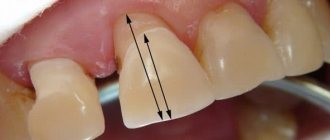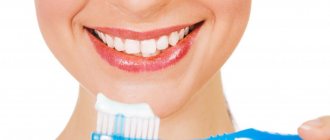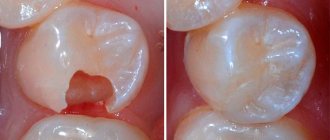Problem: a 35-year-old patient came to the Dial-Dent clinic for a consultation with an orthodontist. The woman was bothered by periodic pain in the temporomandibular joints (TMJ), increased wear and sensitivity of the teeth. The woman wanted to know how to improve the condition of her teeth and bite.
Solution: comprehensive dental rehabilitation was performed - orthodontic treatment with braces, neuromuscular bite adjustment, osteopathic correction, implantation and dental prosthetics in a new bite.
Initial consultation with an orthodontist
During the consultation, the following problems were identified: the absence of the 35th tooth (there is no place for its prosthetics), pathologically deep bite, bruxism, severely worn teeth in the lateral regions, minor chips on the front teeth, displacement of the jaw when opening the mouth, clicking in the TMJ on the left.
Bruxism, deep bite, increased tooth wear, TMJ dysfunction - all these problems, which are of the same nature, will only get worse without proper treatment. Treatment should be carried out comprehensively with the participation of several specialists: an orthodontist, an orthopedist, a neuromuscular dentist, an osteopath.
Prevention
Another way to correct your bite at home is prevention. Parents should take care to prevent problems in their child at a very early age. Prevention consists of the following:
- Proper hygiene must be ensured. It is performed twice a day, morning and evening. The brush should be of medium hardness. To consolidate the effect, it is advisable to rinse your mouth with the elixir solution.
- You need to visit the dentist once every six months. If necessary, you need to remove stones and strengthen the enamel.
- If the bite is broken, you need to get a plate or braces in time.
So, it will not be possible to completely correct the bite at home, but you can improve the condition of the dentition with the help of gymnastics and preventive measures.
Consultation with specialists
At a joint consultation, an orthopedist, an orthodontist and a neuromuscular dentist explained to the patient that the problem could not be solved without serious bite correction. It is important to achieve not only an aesthetic result, but also to maintain the health of the temporomandibular joints. Prosthetics for worn teeth in a habitual bite can cause additional discomfort, headaches, and increased pain in the TMJ. Prosthetics will not be durable; crowns will chip in the same way as teeth, since the source of the problem is the incorrect position of the lower jaw relative to the skull and increased tension in the TMJ. Without correcting the incorrect position of the jaw, no measures will produce results. Therefore, prosthetics must be performed in the correct bite (correct does not mean habitual).
Other methods of bite restoration
Modern dentistry offers a large arsenal of techniques for correcting bites. Experienced orthodontists use different designs depending on the complexity of each specific situation and the wishes of the patient. Let's look at the most popular orthodontic structures below.
Braces
The most common non-removable structures, made from a variety of materials to suit any budget (metal, plastic, ceramics, etc.) guarantee the achievement of the desired treatment results in the shortest possible time with a lower risk of relapse. Equally effective in both simple and very complex cases.
The only drawback is the visibility of braces when communicating with others, as well as the presence of slight discomfort when wearing them.
Aligners or aligners
These structures are removable, so more patients prefer their installation. They are made from hypoallergenic plastic or silicone, they are completely transparent and do not affect their appearance in any way.
Trainers
Another removable design that allows you to cope with minor bite pathologies. It is especially effective in childhood, when the jaw bones are not yet fully strengthened and formed. If there is one drawback, you cannot talk, eat or drink while wearing it.
Operation
Preference for this method is given only in the most complex and advanced cases, when no other method of bite correction can guarantee the desired effect. After surgery, braces or wearing removable structures may also be prescribed.
previous post
Photos of bite correction before and after
next entry
Comprehensive treatment plan
- Neuromuscular bite adjustment, teeth alignment using braces and creating space for implant prosthetics, osteopathic correction.
- Implantation to restore a missing tooth.
- Treatment and preparation of teeth for prosthetics.
- Complete dental prosthetics: crowns for chewing teeth, crowns for implants, veneers for front teeth.
For personal reasons, the patient refused to install veneers on her front teeth. Since the front teeth are the least affected by bruxism, their prosthetics are recommended, and the exclusion of this step does not affect the overall result. It was decided to use prosthetic teeth only in the lateral areas.
The patient agreed with the plan presented. For accurate calculations, in-depth diagnostics are required (photometry, photographs, CT, TRG in lateral projection, casts). The orthodontist combined the diagnostic data obtained, made the necessary calculations and began treatment.
The initial state:
Computed tomography for diagnosing the condition of the TMJ:
Dangers of malocclusion
Many patients ask the question: why treat malocclusion?
Indeed, why interfere with the body if nothing hurts or bothers you? Of course, severe and obvious changes in the bite need to be corrected primarily for aesthetic reasons. A person with an incorrect bite often feels flawed, unsure of himself, and ugly. If this situation can be corrected, it must be done as soon as possible! But why change the bite if it does not interfere with the owner, does not cause discomfort and is noticeable to others? The fact is that even small changes or underdevelopment of the jaw can lead to serious consequences. Firstly, a person does not chew food thoroughly enough, which affects the functioning of the digestive system. It is more difficult for a person with an incorrect bite to swallow, which is why throat diseases are more difficult and occur more often. If a patient has an incorrect bite, this leads to more frequent dental diseases, a predisposition to periodontitis and gingivitis. Such teeth are more difficult to clean and are more susceptible to caries. It is also more difficult to treat such teeth, and especially when it comes to prosthetics. Improper closure of teeth leads to excessive friction in unnecessary places, and tooth enamel suffers as a result. That is why, if you suspect a malocclusion, you need to urgently correct the situation. But what could be the reason for such development of the jaws?
how to straighten teeth at home
Stage I - treatment by an orthodontist and a neuromuscular dentist, osteopathic correction
Diagnosis by orthodontist O.A. Baranova: deep incisal occlusion, bruxism, increased tooth wear, shift of the midline on the lower jaw to the left, TMJ dysfunction on the left, edentia 35.
Diagnosis of neuromuscular dentist A.V. Galeeva: dysfunction of the masticatory muscles and temporomandibular joints.
Before fixing the braces, neuromuscular dentist A.V. Using a myograph, Galeev determined the physiological and stable musculoskeletal position of the lower jaw. To normalize the bite, the existing height of the lower teeth is not enough, so to fix the position of the lower jaw found using a myograph, the doctor made a removable orthotic. The doctor will monitor, analyze and correct the resulting position until the dental system adapts (usually 2-3 months, it is impossible to give exact dates, since all people have different adaptation capabilities).
Below is a photo of the patient before the start of treatment, and with a removable orthotic on her teeth - the bite is “raised”, the contours of the face have become more harmonious, the nasolabial folds have been smoothed out:
After fixing the correct position of the lower jaw, the orthodontist begins the work. Along with the orthodontist, the patient is treated by an osteopathic doctor.
Diagnosis by osteopath A.I. Popova: descending type of osteopathic disorders caused by malocclusion.
Damon braces are fixed to the teeth of the upper jaw. The goals of treatment at this step are to straighten the upper teeth and normalize the shape of the upper dentition. Braces have not yet been installed on the teeth of the lower jaw, since the orthotic is in the adjustment stage as the position of the upper teeth changes. After stabilizing the position of the upper teeth, the removable orthotic will be replaced with a fixed one, and then braces will be installed on the lower teeth.
After 9 months, the orthodontist fixed braces on the teeth of the lower jaw. Before this, the removable orthotic was replaced with a non-removable one.
In the area of the missing 35th tooth, a spring is installed on the bracket system to expand the gap:
After 4 months, the place for prosthetics is almost prepared.
Orthodontic treatment lasted 1 year 9 months. The bite is normalized, a place for prosthetics has been created, clicks and pain in the TMJ have stopped.
The osteopath performed 10 sessions during the orthodontic treatment. The main directions of correction are relieving excess tension from the bones of the skull, muscles of the neck, face, chewing muscles, adapting the body to changes in the position of the lower jaw, and strengthening the correct functioning of the muscles. Osteopathic correction makes the results of bite correction more stable.
Reasons for appearance
Malocclusion develops in early childhood. Often this pathology is hereditary. If the parents suffered from this problem, the child may also develop it. In addition to genetic predisposition, there are other causes of malocclusion:
- Artificial feeding. A newborn baby needs to develop his jaw muscles. When he suckles at his mother's breast, it provides excellent jaw training. If you feed him from a bottle, the jaw muscles will not receive the necessary load, which will provoke the development of pathologies.
- Poor nutrition of a pregnant woman, stress. The lack of essential vitamins and microelements in a pregnant woman’s diet, as well as constant worry and stress, can cause a number of complications in the development of the baby.
- Bad habits of a child. A child's predisposition to thumb sucking, as well as prolonged use of a pacifier, can all contribute to changes in the normal bite.
- Jaw injuries. Facial injuries that result in the absence of some teeth can cause problems with jaw closure. That is why, if you receive a facial injury, you must immediately consult a doctor.
- Breathing through the mouth. Such an innocent problem as nasal congestion can cause serious disturbances in the formation of the jaws. A person constantly breathes through his mouth, and a number of his muscles atrophy over time, which causes a narrowing of the upper jaw.
- Parafunction of the tongue. This disease is characterized by speech impairment. Sometimes a child cannot pronounce certain sounds, as a result of which the articulation of his tongue is impaired - he does not squeeze his teeth enough, which leads to changes in the bite.
The key to successful bite correction is timely fight against it. It is best to deal with this problem from childhood, since the body is in the process of development, and restoration of the normal position of the jaws occurs much faster.
Stage II - tooth implantation
After removing the braces, implant surgeon V.P. Alaverdov installed an Astra Tech dental implant for the patient. The operation lasted 30 minutes and was performed under sedation (in medical sleep). Healing took several months.
The fixed orthotic remains on the teeth until the final dental prosthetics. The dimensions of the orthotic will be harmoniously distributed between the antagonist teeth. Crowns on the teeth will fix the correct position of the bite.
Using braces
Braces are used to eliminate complex bite defects when other methods cannot provide the desired result. This is the most frequently recommended design by doctors for restoring straight teeth. The basis of bite correction with braces is the application of pressure on each tooth, which leads to root displacement and redistribution of connective tissue. Due to this, each dental unit gradually takes its correct position. Despite all the advantages, braces also have their disadvantages:
- quite high cost;
- discomfort when wearing;
- the need for long-term use;
- visibility of the structure to others.
Installing braces is not painful at all. But the patient will need to visit the doctor regularly to adjust the arch and monitor the process of teeth straightening.
Stage III - treatment and preparation of teeth for prosthetics
Before dental prosthetics, it is necessary to prepare the teeth so that they do not disturb the patient some time after the installation of expensive structures. To do this, Dial-Dent conducts a thorough diagnosis of the condition of previously treated canals and, if necessary, treats the canals of the teeth under a microscope, guaranteeing maximum service life of the teeth. To create a zone of attached gum, the surgeon performed periodontal manipulation. The hygienist performed gentle teeth cleaning and applied a special product to the front teeth to eliminate hypersensitivity. All these procedures were performed gradually, at a time convenient for the patient, while the dental implant was healing.
How to change your bite
There are a lot of modern dental techniques that will help you correct your bite in a relatively short time.
- Mouthguards.
These are plastic dentures that are placed on the teeth and can be easily removed if necessary. Aligners can be worn around the clock or only at night (if the bite is slightly changed). They are absolutely transparent and do not cause much discomfort. They are usually used to correct bites in children and adolescents. - Veneers.
These are thin porcelain plates that completely cover the teeth and hide their imperfections. With the help of veneers, you can correct bite defects, while immediately hiding them from others. - Trainers.
This is another modern way to correct your bite. The trainer is a small silicone device that is worn on the lower or upper jaw (sometimes on both). The trainer not only fixes the teeth in the desired position, but also holds the tongue in the correct position and trains the facial and jaw muscles. After wearing the trainer for a long time, the bite remains correct, and the corrected defects no longer return.
Only a doctor can choose a method for correcting the bite, based on the individual characteristics of a particular patient. If you have not yet reached the dentist, you can try to correct the situation at home.
how to keep teeth healthy
Stage IV - dental prosthetics
Prosthetics on an implant, as well as prosthetics of teeth in the lateral sections above and below in a physiological and stable musculoskeletal position of the lower jaw, created all the prerequisites for the correct functioning of the TMJ. Crowns are installed on the teeth on a zirconium dioxide frame.
After dental prosthetics:
How to correct an overbite at home
In fact, it is almost impossible to correct serious violations on your own. However, some minor defects can still be eliminated. The most effective way for this is exercises to develop the facial and jaw muscles. By influencing certain muscle groups, you will achieve their growth and enlargement. By constantly trying to position your jaw in the correct position, rather than in a convenient position, you will gradually develop the necessary muscles and your bite will begin to change. Here is a set of effective exercises that will help you become better and healthier.
- First you need to stretch your jaw. Open your mouth wide and close it rhythmically in several movements. After this, move your lower jaw in one direction or the other.
- Touch the tip of your tongue to the roof of your mouth. Lock yourself in this position. With progressive movements, move inside the oral cavity, that is, to the base of the tongue. Try to advance as long as possible, but do not allow pain in the frenulum area. At maximum distance, open and close your mouth several times.
- Place your elbows on the table and rest your chin on your palm. Open and close your mouth so that only the upper jaw moves along with the head. The lower jaw must be fixed and motionless. Repeat the exercise several times.
- Try to push your lower jaw forward as much as possible. After this, move your jaw back as far as possible.
- Try to correct your bite for a while and be in the opposite state. If, during a habitual bite, the upper teeth cover the lower ones, change their position and stay like that for at least three minutes. This exercises weak jaw muscles.
Each of these exercises must be repeated at least 10 times. The complex must be performed morning and evening if you want to achieve real results. Regular exercise, patience and effort will get your jaw in order without medical intervention.
A beautiful smile wins hearts, but not everyone can boast of this wealth. Modern dental treatment techniques can correct even the most serious pathologies. But often minor problems can be solved on your own by putting stress on the right muscles. And then you can correct your bite at home - without long lines and financial costs. Be healthy, please those around you with a snow-white smile!
how to remove gap between front teeth
Time frame for bite correction
How to quickly correct an overbite in an adult? This question is perhaps the most concerning for those who are thinking about orthodontic treatment. The timing of bite correction practically does not depend on the type of device; the duration of therapy is primarily influenced by the complexity of the clinical case. For example, if you have slight crowding of teeth, then in six months you can achieve quite good results. More complex anomalies will require an average of one to two years. Two and a half years is the maximum period for correcting bites in adults.
Correction of the smile zone and missing anterior incisors
There is an aesthetic problem in the smile area associated with the absence of front teeth, for example, second incisors. Nowadays, it is not uncommon that even their rudiments are missing. It does not cause complaints as long as there are baby teeth in this place, but after their removal the question arises about restoring the defect. In such situations, the orthodontist, orthopedist and implantologist choose a comprehensive treatment strategy. Options are being considered with implantation and prosthetics in this area or orthodontic movement of adjacent teeth with their further restoration with veneers to create a harmonious smile.
A less common situation is the absence of one of the front incisors. If the defect has existed for quite a long time, then problems may arise with implantation in this area due to a lack of bone tissue. Then the orthodontist proposes a treatment plan with moving the lateral incisor to the place of the missing central one, and prosthetics on the implant is carried out in the freed area where there is enough bone tissue.
Surgery
The surgical method is used in the most difficult cases, when correction by other methods does not help. Indications for surgery are:
- irregular chin shape;
- hereditary pathologies of the dental system;
- violation of facial symmetry due to the consequences of injury;
- open bite, in which there are large gaps.
According to the accepted technique, an incision is made in the oral mucosa and bone tissue, the teeth are given the correct position, as a result of which the jaws begin to close as expected. The decision about the need for surgery is made only by the doctor. In this case, the specialist compares the risks of complications with the expected result and makes a final verdict on the need for this particular method of treatment.
Correction of bite with braces in adult patients
As a rule, bite correction in adults is carried out using braces. A wide range of types of braces for adults allows the doctor to choose the appropriate brace system for a particular case, taking into account the wishes of the patient, ranging from traditional metal ones to invisible lingual ones. If you do not want to show off your orthodontic treatment to others, then it makes sense to choose to correct your bite with braces that are attached to the inside of your teeth. They are not visible when a person smiles or talks. However, this device for correcting the bite is more expensive than systems that are fixed on the outside of the teeth.
Orthodontic treatment in the presence of restorations
If dental prosthetics is necessary, before starting orthodontic treatment, the orthopedist plans to install special, milled plastic crowns for the period of wearing the braces. Such structures withstand the fixation of locks and the movement of teeth well; after the orthodontist completes the work, it will be necessary to replace the temporary crowns with permanent ones, taking into account the corrected bite.
The retainer is not glued to orthopedic structures, with the exception of veneers - in this case the inner surface of the tooth is not affected and the retainer will be securely fixed. It is almost impossible to glue a retainer onto ceramic crowns, so a retention tray is provided for patients with such structures. The first year after completion of treatment, it will relieve the load on the front teeth and will be a retaining factor, guaranteeing the stability of the result.
Rate this material:
4.7

